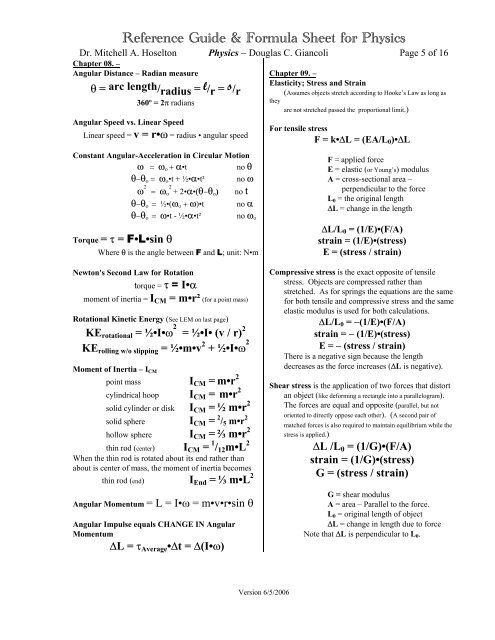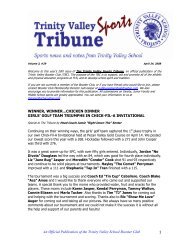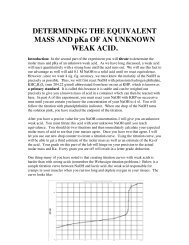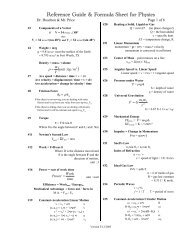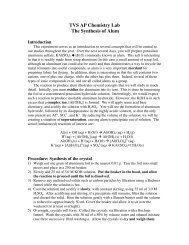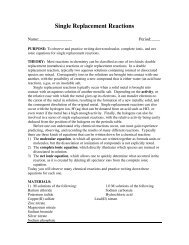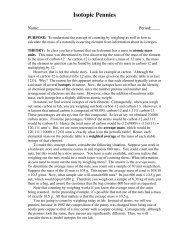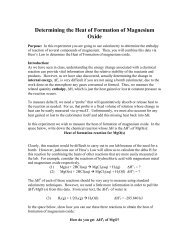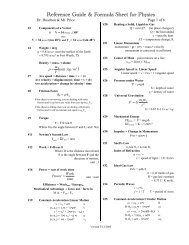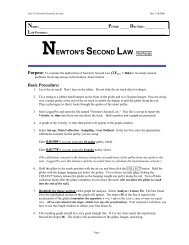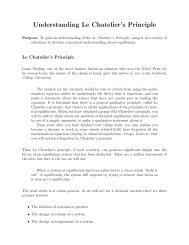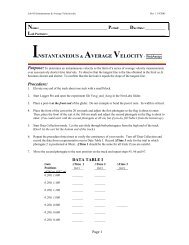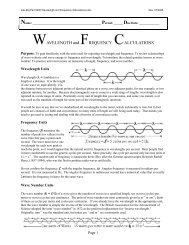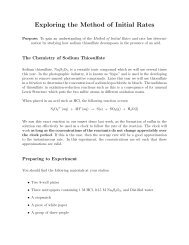Reference Guide & Formula Sheet for Physics - 2006 Version
Reference Guide & Formula Sheet for Physics - 2006 Version
Reference Guide & Formula Sheet for Physics - 2006 Version
You also want an ePaper? Increase the reach of your titles
YUMPU automatically turns print PDFs into web optimized ePapers that Google loves.
<strong>Reference</strong> <strong>Guide</strong> & <strong>Formula</strong> <strong>Sheet</strong> <strong>for</strong> <strong>Physics</strong><br />
Dr. Mitchell A. Hoselton <strong>Physics</strong> − Douglas C. Giancoli Page 5 of 16<br />
Chapter 08. –<br />
Angular Distance – Radian measure<br />
θ = arc length/radius = l/r = s / r<br />
360º = 2π radians<br />
Angular Speed vs. Linear Speed<br />
Linear speed = v = r•ω = radius • angular speed<br />
Constant Angular-Acceleration in Circular Motion<br />
ω = ω ο + α•t<br />
no θ<br />
θ−θ ο = ω ο •t + ½•α•t² no ω<br />
ω 2 2<br />
= ω ο + 2•α•(θ−θο ) no t<br />
θ−θ ο = ½•(ω ο + ω)•t no α<br />
θ−θ ο = ω•t - ½•α•t² no ω ο<br />
Torque = τ = F•L•sin θ<br />
Where θ is the angle between F and L; unit: N•m<br />
Chapter 09. –<br />
Elasticity; Stress and Strain<br />
(Assumes objects stretch according to Hooke’s Law as long as<br />
they<br />
are not stretched passed the proportional limit.)<br />
For tensile stress<br />
F = k•∆L = (EA/L 0 )•∆L<br />
F = applied <strong>for</strong>ce<br />
E = elastic (or Young’s) modulus<br />
A = cross-sectional area –<br />
perpendicular to the <strong>for</strong>ce<br />
L 0 = the original length<br />
∆L = change in the length<br />
∆L/L 0 = (1/E)•(F/A)<br />
strain = (1/E)•(stress)<br />
E = (stress / strain)<br />
Newton's Second Law <strong>for</strong> Rotation<br />
torque = τ = I•α<br />
moment of inertia = I CM = m•r² (<strong>for</strong> a point mass)<br />
Rotational Kinetic Energy (See LEM on last page)<br />
KE rotational = ½•I•ω 2 = ½•I• (v / r) 2<br />
KE rolling w/o slipping = ½•m•v 2 + ½•I•ω 2<br />
Moment of Inertia – I CM<br />
point mass I CM = m•r 2<br />
cylindrical hoop I CM = m•r 2<br />
solid cylinder or disk I CM = ½ m•r 2<br />
solid sphere I CM = 2 / 5 m•r 2<br />
hollow sphere I CM = ⅔ m•r 2<br />
thin rod (center) I CM = 1 / 12 m•L 2<br />
When the thin rod is rotated about its end rather than<br />
about is center of mass, the moment of inertia becomes<br />
thin rod (end) I End = ⅓ m•L 2<br />
Angular Momentum = L = I•ω = m•v•r•sin θ<br />
Angular Impulse equals CHANGE IN Angular<br />
Momentum<br />
∆L = τ Average •∆t = ∆(I•ω)<br />
Compressive stress is the exact opposite of tensile<br />
stress. Objects are compressed rather than<br />
stretched. As <strong>for</strong> springs the equations are the same<br />
<strong>for</strong> both tensile and compressive stress and the same<br />
elastic modulus is used <strong>for</strong> both calculations.<br />
∆L/L 0 = −(1/E)•(F/A)<br />
strain = − (1/E)•(stress)<br />
E = − (stress / strain)<br />
There is a negative sign because the length<br />
decreases as the <strong>for</strong>ce increases (∆L is negative).<br />
Shear stress is the application of two <strong>for</strong>ces that distort<br />
an object (like de<strong>for</strong>ming a rectangle into a parallelogram).<br />
The <strong>for</strong>ces are equal and opposite (parallel, but not<br />
oriented to directly oppose each other). (A second pair of<br />
matched <strong>for</strong>ces is also required to maintain equilibrium while the<br />
stress is applied.)<br />
∆L /L 0 = (1/G)•(F/A)<br />
strain = (1/G)•(stress)<br />
G = (stress / strain)<br />
G = shear modulus<br />
A = area – Parallel to the <strong>for</strong>ce.<br />
L 0 = original length of object<br />
∆L = change in length due to <strong>for</strong>ce<br />
Note that ∆L is perpendicular to L 0 .<br />
<strong>Version</strong> 6/5/<strong>2006</strong>


